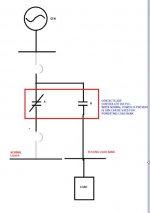Hello All,
I am looking for any ideas and a sample electrical design if available. A design to feed I want to connect and feed a separate load contactor-based design to switch between different loads when from a source. As shown in the attached picture (it is high level) the generator feeds the normal loads during utility outages or emergencies but when the generator is not being used it feeds the load bank. The PLC will control the contactor operation (open and close), generator signal (start and stop), and sense voltage. I have seen something similar done with motorized/electrically operated breakers with PLC control. I was wondering if something similar can be done with relay-based contactors as shown (like how in 83 throw-over for control power switching). The reason to do this is cost and footprint. If all this can be accommodated in a small enclosure rather than a big electrical panel. Please do provide thoughts and if possible share similar designs. I am concerned with the contactor breaking capacity and are there lighting contactors for 600Vac rating small enough to be wired in an enclosure and wired for automation?
I am looking for any ideas and a sample electrical design if available. A design to feed I want to connect and feed a separate load contactor-based design to switch between different loads when from a source. As shown in the attached picture (it is high level) the generator feeds the normal loads during utility outages or emergencies but when the generator is not being used it feeds the load bank. The PLC will control the contactor operation (open and close), generator signal (start and stop), and sense voltage. I have seen something similar done with motorized/electrically operated breakers with PLC control. I was wondering if something similar can be done with relay-based contactors as shown (like how in 83 throw-over for control power switching). The reason to do this is cost and footprint. If all this can be accommodated in a small enclosure rather than a big electrical panel. Please do provide thoughts and if possible share similar designs. I am concerned with the contactor breaking capacity and are there lighting contactors for 600Vac rating small enough to be wired in an enclosure and wired for automation?


